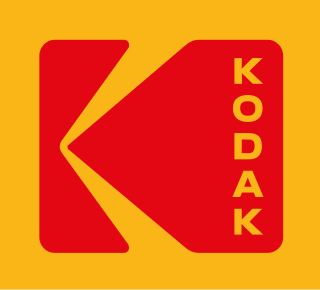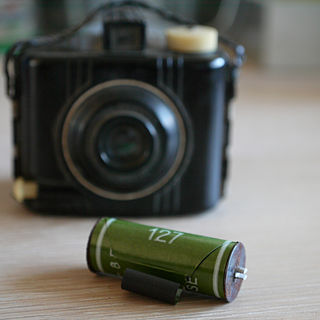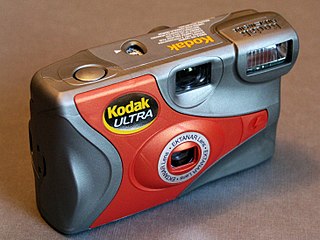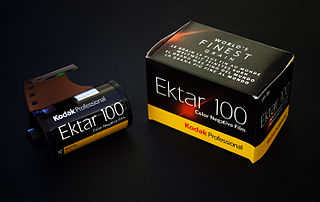
35 mm film is a film gauge used in filmmaking, and the film standard. In motion pictures that record on film, 35 mm is the most commonly used gauge. The name of the gauge is not a direct measurement, and refers to the nominal width of the 35 mm format photographic film, which consists of strips 1.377 ± 0.001 inches (34.976 ± 0.025 mm) wide. The standard image exposure length on 35 mm for movies is four perforations per frame along both edges, which results in 16 frames per foot of film.

The Eastman Kodak Company is an American public company that produces various products related to its historic basis in analogue photography. The company is headquartered in Rochester, New York, and is incorporated in New Jersey. It is best known for photographic film products, which it brought to a mass market for the first time.

127 is a roll film format for still photography introduced by Kodak in 1912.

Kodachrome is the brand name for a color reversal film introduced by Eastman Kodak in 1935. It was one of the first successful color materials and was used for both cinematography and still photography. For many years, Kodachrome was widely used for professional color photography, especially for images intended for publication in print media.

A disposable or single-use camera is a simple box camera meant to be used once. Most use fixed-focus lenses. Some are equipped with an integrated flash unit, and there are even waterproof versions for underwater photography. Internally, the cameras use a 135 film or an APS cartridge.
The Instamatic is a series of inexpensive, easy-to-load 126 and 110 cameras made by Kodak beginning in 1963. The Instamatic was immensely successful, introducing a generation to low-cost photography and spawning numerous imitators.

An instant camera is a camera which uses self-developing film to create a chemically developed print shortly after taking the picture. Polaroid Corporation pioneered consumer-friendly instant cameras and film, and were followed by various other manufacturers.

Color photography is photography that uses media capable of capturing and reproducing colors. By contrast, black-and-white or gray-monochrome photography records only a single channel of luminance (brightness) and uses media capable only of showing shades of gray.
Photographic printing is the process of producing a final image on paper for viewing, using chemically sensitized paper. The paper is exposed to a photographic negative, a positive transparency , or a digital image file projected using an enlarger or digital exposure unit such as a LightJet or Minilab printer. Alternatively, the negative or transparency may be placed atop the paper and directly exposed, creating a contact print. Digital photographs are commonly printed on plain paper, for example by a color printer, but this is not considered "photographic printing".

Instant film is a type of photographic film that was introduced by Polaroid Corporation to produce a visible image within minutes or seconds of the photograph's exposure. The film contains the chemicals needed for developing and fixing the photograph, and the camera exposes and initiates the developing process after a photo has been taken.

Photo CD is a system designed by Kodak for digitizing and saving photos onto a CD. Launched in 1991, the discs were designed to hold nearly 100 high quality images, scanned prints and slides using special proprietary encoding. Photo CDs are defined in the Beige Book and conform to the CD-ROM XA and CD-i Bridge specifications as well. They were intended to play on CD-i players, Photo CD players, and any computer with a suitable software.

Kodak Ektar is a professional color negative film introduced in 2008, designed for nature, outdoors, fashion, and product photography. The film offers ultra-fine grains, ultra-vivid colors, and high saturation, and is available in ISO 100 only.

Kodak EasyShare was a sub brand of Eastman Kodak Company products identifying a consumer photography system of digital cameras, snapshot thermal printers, snapshot thermal printer docks, all-in-one inkjet printers, accessories, camera docks, software, and online print services. The brand was introduced in 2001. The brand is no longer applied to all-in-one inkjet printers or online printing services. Thermal snapshot printers and printer docks product lines have been discontinued. In 2012, Kodak stopped manufacturing and selling all digital cameras and photo frames. As a result, all Kodak EasyShare digital cameras and all-in-one printers were also discontinued.
Film tinting is the process of adding color to black-and-white film, usually by means of soaking the film in dye and staining the film emulsion. The effect is that all of the light shining through is filtered, so that what would be white light becomes light of some color.
A film base is a transparent substrate which acts as a support medium for the photosensitive emulsion that lies atop it. Despite the numerous layers and coatings associated with the emulsion layer, the base generally accounts for the vast majority of the thickness of any given film stock. Since the late 19th century, there have been three major types of film base in use: nitrate, acetate, and polyester.

Color motion picture film refers both to unexposed color photographic film in a format suitable for use in a motion picture camera, and to finished motion picture film, ready for use in a projector, which bears images in color.

Analog photography, known as film photography, is an incorrect term for photography that uses chemical processes to capture an image, typically on paper, film or a hard plate. Analog is a word used to define what a video signal was before digital came along. These photographic processes were the only methods available to photographers for more than a century prior to the invention of digital photography, which uses electronic sensors to record images to digital media.
Pathécolor, later renamed Pathéchrome, was an early mechanical stencil-based film tinting process for movies developed by Segundo de Chomón for Pathé in the early 20th century. Among the last feature films to use this process were the British revue film Elstree Calling (1930) and the Mexican film Robinson Crusoe (1954) by Spanish Surrealist Luis Buñuel. The Pathécolor stencil process should not be confused with the later Pathécolor, Pathé Color and Color by Pathé trade names seen in screen credits and advertising materials. Like Metrocolor, WarnerColor and Color by DeLuxe, these were simply rebrandings, for advertising purposes, of the use of Eastman Kodak's Eastmancolor color negative film for the original photography.

Photographic film is a strip or sheet of transparent film base coated on one side with a gelatin emulsion containing microscopically small light-sensitive silver halide crystals. The sizes and other characteristics of the crystals determine the sensitivity, contrast, and resolution of the film.

Shades of white are colors that differ only slightly from pure white. Variations of white include what are commonly termed off-white colors, which may be considered part of a neutral color scheme or yellow that looks like brown.














